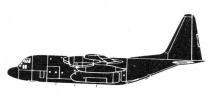Incident Overview

Description
A Lockheed C-130J Hercules transport plane sustained substantial damage in a hard landing accident at Forward Operating Base Shank in Logar province, Afghanistan. There were no injuries. The C-130, assigned to the 41st Airlift Squadron, 19th Airlift Wing, was conducting a medical evacuation when the accident occurred. The accident happened on the third of five planned legs that day to an airfield that was at 6,809 feet Mean Sea Level (MSL) and experiencing winds varying from 200 to 250 degrees gusting from 6 to 28 knots. On the second attempted landing, the aircraft touched down approximately 1,500 ft down the runway but was 27 knots indicated airspeed (KIAS) faster than computed touchdown landing speed leading to the aircraft going off the end of the runway at approximately 49 KIAS. It struck a ditch which collapsed the nose gear and eventually ripped the right main landing gear from the fuselage. The right outboard engine struck the ground, pressurized fuel and oil lines were broken, fluid was sprayed over the cracked engine casing, and the right wing caught fire. The aircraft came to a full stop at approximately 544 feet off the end of the paved runway surface. The Accident Investigation Board (AIB) president found, by clear and convincing evidence, that the causes of the accident were poor Crew Resource Management (CRM) and mishap pilot one’s (MP1) late power reduction causing a 27 KIAS fast touchdown at a high altitude airfield (6,809 ft MSL). Additionally, the AIB President found by the preponderance of evidence that each of the following factors substantially contributed to the mishap: 1) Channelized Attention; 2) Risk Assessment; 3) Delayed Necessary Action; 4) Response Set; 5) Procedural Error.
Source of Information
http://www.stripes.com/news/middle-east/no-injuries-as-c-130-makes-hard-landing-in-afghanistan-1.221629, https://medium.com/war-is-boring/b5811e2523e8http://www.stripes.com/news/middle-east/no-injuries-as-c-130-makes-hard-landing-in-afghanistan-1.221629, https://medium.com/war-is-boring/b5811e2523e8Primary Cause
Poor Crew Resource Management (CRM) and mishap pilot one’s (MP1) late power reduction, causing a 27 KIAS fast touchdown at a high altitude airfield.Poor Crew Resource Management (CRM) and mishap pilot one’s (MP1) late power reduction, causing a 27 KIAS fast touchdown at a high altitude airfield.Share on:



